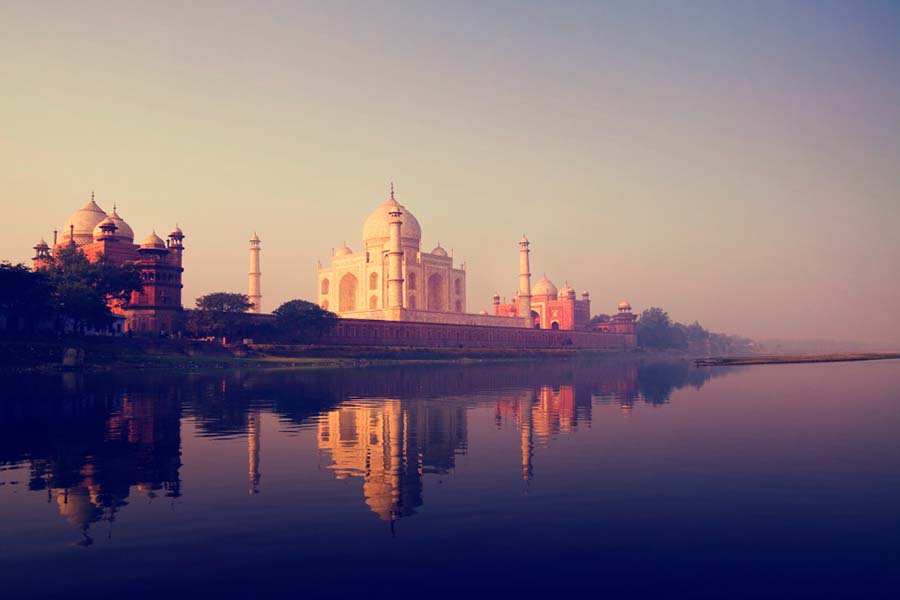Unveiling India’s Iconic Heritage: A Journey Through Time

India, diverse and vibrant, is renowned for its rich history and cultural heritage. The nation proudly boasts numerous famous landmarks that have stood the test of time and continue to captivate visitors from around the globe. In this blog, we will explore some of the most iconic landmarks in India and delve into their historical and cultural importance.
Taj Mahal: A Symbol of Eternal Love and Architectural Marvel
Without a doubt, the Taj Mahal, located in Agra, Uttar Pradesh, stands as India’s most renowned landmark. As a splendid mausoleum crafted from white marble, it holds the esteemed title of one of the Seven Wonders of the World, drawing millions of visitors each year.
Erected during the 17th century by Emperor Shah Jahan in devotion to his beloved wife, Mumtaz Mahal, the Taj Mahal stands as an enduring emblem of eternal love and an architectural masterpiece. Its balanced layout, detailed engravings, and superb marble inlays epitomise the exquisite artistry of the Mughal period. Adorned with precious gemstones throughout, the entire edifice radiates with magnificence.
The Taj Mahal’s grand dome, minarets, and reflecting pool create a mesmerising sight, especially during sunrise and sunset. The changing hues of the marble, from soft pink in the morning to dazzling white during the day and a golden glow at sunset, evoke a sense of awe and wonder. Visitors can explore the beautifully manicured gardens surrounding the mausoleum, which add to the overall charm and serenity of the place.
Key Points:
The Taj Mahal is located in Agra, Uttar Pradesh, and is considered one of the World’s Seven Wonders.
Emperor Shah Jahan built it to symbolise love for his wife, Mumtaz Mahal.
The Taj Mahal showcases the finest craftsmanship of the Mughal era with its symmetrical design, intricate carvings, and exquisite marble inlay work.
Visitors can witness the changing hues of the marble at different times of the day, creating a captivating visual experience.
The surrounding gardens enhance the overall charm and serenity of the Taj Mahal.
Red Fort: Witness to India’s Historical Significance
Delving into the pages of Indian history, we encounter another iconic landmark, the Red Fort in Delhi. Constructed by the Mughal emperor Shah Jahan in the 17th century, this UNESCO World Heritage Site served as the residence of Mughal emperors for nearly 200 years.
The Red Fort, also known as Lal Qila, is a magnificent red sandstone fort that showcases a fusion of Persian, Islamic, and Indian architectural styles. Its colossal walls, adorned with intricate decoration, enclose fascinating palaces, gardens, and audience halls. Walking through the massive gates of the Red Fort, visitors can immerse themselves in the grandeur and luxury of the Mughal era.
Apart from its architectural significance, the Red Fort holds immense historical importance. From here, the Prime Minister of India hoists the national flag every year on Independence Day, commemorating the country’s freedom from British rule. The fort has witnessed numerous significant events throughout history, symbolising India’s struggle for independence and a reminder of the nation’s rich heritage.
Key Points:
The Red Fort, located in Delhi, served as the residence of Mughal emperors for nearly 200 years.
It showcases a fusion of Persian, Islamic, and Indian architectural styles.
The fort’s colossal walls, intricate decoration, and fascinating palaces create a sense of grandeur and luxury.
The Red Fort is where the Prime Minister of India hoists the national flag on Independence Day, symbolising the country’s freedom from British rule.
It stands as a witness to India’s struggle for independence and reflects the nation’s rich heritage.
Golden Temple: A Spiritual Abode of Peace and Harmony
Moving towards the northern regions of India, we come across the Golden Temple, also known as Sri Harmandir Sahib. Located in Amritsar, Punjab, this sacred shrine is the holiest pilgrimage site for Sikhs.
The Golden Temple is a testament to the Sikh principles of equality, tolerance, and service to humanity. Its stunning golden façade, surrounded by a serene and holy water tank called the Amrit Sarovar, creates a surreal ambience. The temple complex is a harmonious blend of Islamic and Hindu architectural styles, representing the inclusive nature of Sikhism.
Visitors to the Golden Temple experience a sense of tranquillity and spiritual awakening. The mesmerising Gurbani Kirtan (hymn recitals) and the rhythmic sounds of the Sikh musical instruments, such as the harmonium and tabla, create a soothing atmosphere. The community kitchen or langar, where thousands of people are fed daily, regardless of their background, embodies the Sikh principle of selfless service and equality.
Key Points:
The Golden Temple, located in Amritsar, Punjab, is the holiest pilgrimage site for Sikhs.
It represents the Sikh principles of equality, tolerance, and service to humanity.
The stunning golden façade and the holy water tank create a serene and surreal ambience.
The temple complex showcases a blend of Islamic and Hindu architectural styles, symbolising the inclusive nature of Sikhism.
Visitors can experience tranquillity, attend hymn recitals, and witness the community kitchen, which serves free meals to all.
Gateway of India: A Historical Landmark and Iconic Symbol of Mumbai
Situated in the bustling city of Mumbai, the Gateway of India is an architectural marvel that symbolises India’s colonial history. Built to commemorate the arrival of King George V and Queen Mary in 1911, this Indo-Saracenic-style arch monument has become an iconic landmark of the city.
The Gateway of India overlooks the Arabian Sea and has witnessed several important historical events. It served as the ceremonial entrance to India for British rulers and governors and later became a popular tourist attraction. The colossal structure, adorned with intricate stone latticework, showcases a blend of Hindu and Islamic architectural styles.
Visitors can enjoy a scenic boat ride to the nearby Elephanta Caves or soak in this historical site’s magnificent view of the Arabian Sea. The Gateway of India has witnessed the changing tides of Mumbai’s history, and its grandeur continues to enthral locals and tourists alike.
Key Points:
The Gateway of India, located in Mumbai, is an architectural marvel and a symbol of India’s colonial history.
It was built to commemorate the arrival of King George V and Queen Mary in 1911.
The monument served as the ceremonial entrance to India for British rulers and governors.
It overlooks the Arabian Sea and offers a magnificent view of the surrounding coastline.
The Gateway of India showcases a blend of Hindu and Islamic architectural styles, adding to its grandeur.
Ajanta and Ellora Caves: Masterpieces of Ancient Indian Art and Architecture
Nestled in Maharashtra, the Ajanta and Ellora Caves are a UNESCO World Heritage Site and illustrate the brilliance of ancient Indian art and architecture. These rock-cut caves date back to the 2nd century BCE and 5th century CE and serve as a testament to the rich cultural heritage of India.
The Ajanta Caves showcase exquisite Buddhist rock-cut sculptures and paintings depicting stories from the life of Buddha and various other mythological tales. The artworks’ intricate details and vibrant colours are a true marvel, reflecting the artistic skills of the ancient artisans. Visitors explore the dark caves and are transported to a bygone era, where art and spirituality intertwine.
On the other hand, the Ellora Caves exhibit a harmonious blend of Hindu, Buddhist, and Jain art, displaying intricate carvings and awe-inspiring temples. The Kailash Temple, a monolithic structure carved out of a single rock, is the highlight of the Ellora Caves and is dedicated to Lord Shiva. The sheer scale and complexity of the carvings leave visitors spellbound, showcasing the architectural genius of ancient India.
Key Points:
The Ajanta and Ellora Caves in Maharashtra are UNESCO World Heritage Sites.
The Ajanta Caves showcase Buddhist rock-cut sculptures and paintings depicting stories from the life of Buddha.
The Ellora Caves exhibit a blend of Hindu, Buddhist, and Jain art, featuring intricate carvings and awe-inspiring temples.
The Kailash Temple in the Ellora Caves, dedicated to Lord Shiva, is a monolithic structure carved from a single rock.
The caves highlight the rich cultural heritage of India and reflect the artistic and architectural brilliance of ancient artisans.
Conclusion
India’s famous landmarks serve as architectural marvels and repositories of history, culture, and spirituality. The Taj Mahal, Red Fort, Golden Temple, Gateway of India, Ajanta, and Ellora Caves are just a glimpse into the vast treasure trove of India’s cultural heritage. Exploring these iconic landmarks allows visitors to delve into the rich history and experience the cultural significance that has shaped the nation over centuries.
So, whether you are captivated by the eternal love of the Taj Mahal, mesmerised by the architectural brilliance of the Red Fort, seeking spiritual solace at the Golden Temple, admiring the colonial charm of the Gateway of India, or marvelling at the intricate art of the Ajanta and Ellora Caves, India’s famous landmarks promise an enriching journey through time and culture.
If you found this post engaging, don’t forget to explore our additional blogs below.
- Zoom-Ready Fashion: Must-Have Styles for Virtual Meetings!
- Jet-Setter Must-Haves: Fashionable Travel Essentials!
- Unlock Wealth Secrets: Rich Dad Poor Dad Reveals All!
- Unleash Your Earning Potential: Mastering the Gig Economy Game!
- Unlock Your Peak Performance: Fast This Way with Dave Asprey!
- Revolutionise Your Kitchen: Master Zero-Waste Cooking Magic!
- Wild Adventures and Hilarious Mishaps: Bill Bryson’s Appalachian Trail Tale!
- Mastering AutoML: Perks, Uses & Hurdles Uncovered
- Love Unveiled: Cracking the Code of Relationships with John Gray!
- Unlocking Forever: Master the Secrets to Relationship Bliss!
Sign up for updates on this blog and our latest posts if you enjoyed reading this one.
Help your friends and colleagues stay informed about the newest insights on business, marketing, finance, lifestyle, and society by sharing our blog content through Facebook, Twitter, Pinterest, LinkedIn, email, or WhatsApp links below. We can create a knowledge-sharing community and empower one another to accomplish and experience our objectives.
FAQ
Where is the Taj Mahal located, and what is its significance?
The Taj Mahal is located in Agra, Uttar Pradesh, and is considered one of the World’s Seven Wonders. Emperor Shah Jahan built it to symbolise love for his wife, Mumtaz Mahal. The Taj Mahal showcases the finest craftsmanship of the Mughal era with its symmetrical design, intricate carvings, and exquisite marble inlay work.
What is the historical importance of the Red Fort?
The Red Fort, located in Delhi, served as the residence of Mughal emperors for nearly 200 years. It showcases a fusion of Persian, Islamic, and Indian architectural styles. The fort’s colossal walls, intricate decoration, and fascinating palaces create a sense of grandeur and luxury. The Red Fort is where the Prime Minister of India hoists the national flag on Independence Day, symbolising the country’s freedom from British rule.
Where is the Golden Temple located, and what does it represent?
The Golden Temple, located in Amritsar, Punjab, is the holiest pilgrimage site for Sikhs. It represents the Sikh principles of equality, tolerance, and service to humanity. The stunning golden façade and the holy water tank create a serene and surreal ambience. The temple complex showcases a blend of Islamic and Hindu architectural styles, symbolising the inclusive nature of Sikhism.
What is the significance of the Gateway of India?
The Gateway of India, located in Mumbai, is an architectural marvel and a symbol of India’s colonial history. It was built to commemorate the arrival of King George V and Queen Mary in 1911. The monument served as the ceremonial entrance to India for British rulers and governors. It overlooks the Arabian Sea and offers a magnificent view of the surrounding coastline. The Gateway of India showcases a blend of Hindu and Islamic architectural styles, adding to its grandeur.
Credits
Featured image by rawpixel.com on Freepik.









